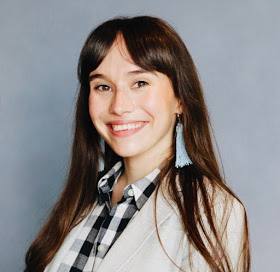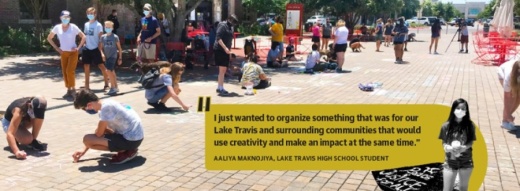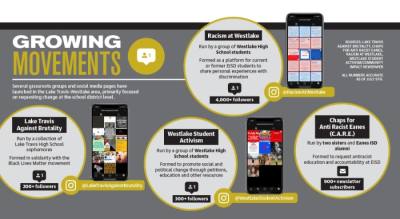But as the once-in-a-generation pandemic has forced local district officials to scramble for possible methods of carrying out the 2020-21 school year, another issue has emerged and led to leaders not just at EISD, but throughout the Lake Travis-Westlake area to respond.
One catalyst that has led to decisive action regarding a shift in policy toward racial issues locally happened June 3.
An incendiary video was posted on Twitter that showed a group of 2020 Westlake High School graduates hurling racial slurs at protesters in downtown Austin. The post, which has since been removed, sparked outrage throughout the Westlake community and beyond, and quickly triggered a response from EISD officials.
“We are appalled by the conduct of these recent Westlake graduates. We do not condone their behavior or actions,” said representatives of EISD in a statement June 4.
That video, combined with growing protests occurring throughout the Greater Austin metro, has helped propel major policy discussions within several areas of western Travis County, especially in Westlake.
“Certainly, the COVID-19 pandemic has challenged us on many levels, but what we are seeing now is a different kind of challenge ... one that reinforces the importance of dialogue, listening and reflection,” Leonard said.
But it’s not just the Westlake area and EISD where hard conversations and advancements toward change are taking place.
Students at neighboring district Lake Travis ISD have launched their own group in response to the growing movement of national protests set off by the killing of George Floyd by a Minneapolis police officer, and protests and events meant to continue conversations about race and inequality have occurred from Bee Cave to the Four Points area since early June.
From student-run campaigns to community-organized Black Lives Matter protests, residents and officials throughout western Travis County are responding to the evolving socio-political movement.
A movement finds support in Westlake
More than 60 alumni, students and parents submitted testimonials during a June 9 EISD district study session that shined a light on years of what they described as problematic traditions and behavior within the district.
The meeting took place days after the emergence of a new grassroots group called Chaps for Black Lives Matter, which was founded by two sisters and EISD alumnae, Michelle and Danielle Suh.
Within a week of its formation, more than 900 EISD community members signed a letter drafted by the Chaps for Black Lives Matter condemning racist behavior within the community, especially that which was demonstrated in the June 3 video posted on Twitter.
“Statements that Eanes ISD does not ‘condone their behavior or their actions’ fall flat when students are nevertheless allowed to be racist with no consequences,” Michelle and Danielle wrote in the Chaps for BLM letter to the district.
Both Suh sisters grew up in EISD and graduated from Westlake High School in 2010 and 2011. They said that while they both have great respect for their alma mater, they feel they could have benefited from education regarding racial inequality and injustice during their time at WHS.
“I first interacted with these issues in college and was shocked to hear that so many of my classmates had begun having these conversations much earlier,” Danielle said. “I think their understanding of these topics was so much more nuanced than mine was.”
But anti-racist education is only one of the suggestions outlined by Chaps for BLM. The group has encouraged EISD to hire a third-party diversity consultant, implement diversity and equity curricula and increase accountability for racist actions.
Danielle and Michelle’s suggestions were echoed throughout the public comments section of the June 9 board study session, during which dozens of former students recounted difficult experiences while students at EISD.
“Being Black at Westlake High School was exhausting,” alumna Lauren Turner said. “Not a week went by that I did not hear the N-word directed at me or one of my Black peers.”
Turner also remembered feeling afraid to attend football games, where she said students would often chant, “We’re rich, we’re white, we’re Westlake.”
Leonard said the district has made considerable efforts to dismantle these traditions, citing the chant as one example and stating it no longer exists. Still, Danielle and Michelle’s focus is on how the district can improve moving forward, and EISD has already pledged reforms.
As a result of initial discussions and meetings led by the district and community activists, policy shifts are beginning to take shape.
Community members can anticipate receiving a catalog of anti-racist resources from the district, and the student handbook will be updated before the start of the 2020-21 school year, according to representatives of Chaps for BLM.
During a mid-June meeting with Danielle and Michelle, Leonard also committed to hiring a diversity, equity and inclusion facilitator, or DEI—a decision he made public at a June 23 board meeting.
Leonard confirmed during the same meeting that EISD will promote social justice and address racism by examining hiring practices, staff development and teaching.
“Eanes is a wonderful district ... even though we may be good at something, we always want to be better,” Leonard said. “This is a time where every institution; every individual needs to look inside and see where [they can] improve.”
Peaceful protests rise in Lake Travis
In the nearby Lake Travis area, LTISD Superintendent Brad Lancaster echoed Leonard’s statement.
As a superintendent, Lancaster said he’s grappled with his role in nationwide discourse and has usually decided not to address social issues. However, struck by the images of Floyd’s death, Lancaster spoke out in a June 4 statement.
“As a school district, if we do our job right, maybe we can prevent this from happening again,” Lancaster said, adding that LTISD will strive for campuses free of prejudice.
Aaliya Maknojiya, a sophomore at Lake Travis High School, said she agrees with the need to cast out discrimination, and said LTISD, and every district, could benefit from anti-racist policies.
While they are waiting for those districtwide shifts to come to fruition, Maknojiya and a group of classmates have taken to social media with the goal of spreading the information themselves.
Since it launched at the beginning of June, Maknojiya’s new platform, Lake Travis Against Brutality, has gained more than 200 followers on Instagram. She said that platform is where the group regularly shares books and documentaries on social justice issues, as well as news on local protests.
As a 16 year-old, Maknojiya said she may have felt unsafe attending large protests in downtown Austin, but she wanted to give young people a chance for their voices to be heard. With support from the Bee Cave Police Department and Chief Gary Miller, she organized a demonstration.
Trayvon Martin, George Floyd and Michael Ramos, a Black male from Austin who recently died at the hands of police, were just some of the names memorialized in chalk during the June 13 protest.
The event took place at the Hill Country Galleria and was held in solidarity with the Black Lives Matter movement. Rather than holding signs, participants created chalk drawings throughout the center’s main plaza in front of the Bee Cave Public Library.
“I just wanted to organize something that was for our Lake Travis and surrounding communities that would use creativity and make an impact at the same time,” Maknojiya said.
Organizers provided attendees with chalk, water and hand sanitizer. A booth located outside of the library showcased QR codes for individuals to sign petitions or make donations to organizations such as the National Association for the Advancement of Colored People.
Similar demonstrations have emerged throughout the Lake Travis area, and community leaders have responded publicly to the evolving movement.
Two Steiner Ranch-area mothers, Tonya Frederic and Amirta Adhikary, organized a crowd of more than 100 protesters at RM 620 and RM 2222 on June 5. It was the second event they hosted in a week.
Like Maknojiya, Frederic said she wanted to give families and local youth the chance to show their support in a safe, suburban setting.
“A lot of people out here are eager to show their support for the Black community and Black Lives Matter,” Frederic said.
The peaceful demonstrations occurred with support from local leaders and the Lakeway Police Department, who were present at the June 5 event.
On day prior on June 4, Lakeway Mayor Sandy Cox talked about recent protests during her weekly address to the city’s residents via a Facebook Live broadcast.
Cox confirmed the peaceful nature of ongoing protests in the area and encouraged residents to express their frustrations in a civil manner.
“I’d be very remiss if I went straight to COVID-19 and didn’t address
the death of George Floyd,” Cox said. “It’s personal for any and every
one of us.”
Change on the horizon the death of George Floyd,” Cox said. “It’s personal for any and every
one of us.”
The movement in support of racial equality shows no sign of slowing in the near future, as protests and policy change continue to occur nationwide and in the Lake Travis-Westlake area.
Lancaster, Leonard and several students have agreed that the first step towards achieving social change could begin at the school district level.
During the June 23 meeting, Leonard referred to a famous Nelson Mandela quote, “No one is born hating another person because of the color of his skin...”
If youth in the Westlake area are learning this hatred, Leonard said, it is imperative that EISD and the surrounding community teach those children to “unhate.” He noted this goal may be difficult to carry out in force amid a global health pandemic, but stated EISD is capable of tackling more than one challenge.
“We need to listen,” he said. “Our school district is a reflection of the community, and the community is a reflection of our school district.”







